Evernote
- Notes in the YouTube notebook already had to have the “YouTube” tag because that’s how I can filter them once they are moved to the Timeline notebook.
- I was already using the YouTube notebook for other creator related notes, like ideas for my articles.
- YouTube
- Articles
- Posts
- To have that information automatically dated, as each note has a creation date.
- To be able to reuse the information in other notes. For example, a team member note would be dragged to and linked to a meeting note.
I’m down to 5 plugins on Obsidian now, and I’m happy with that. However, there is still work to be done regarding the organization of information between Obsidian and Evernote. 🤔 Maybe there is an opportunity for a video on this.
Unraveling the mess I created using Evernote and Obsidian
I don’t have any clients today, but I’ve decided not to write scripts or edit videos. I am putting my energy into unraveling the mess I created after simultaneously using Evernote and Obsidian for a while now. Both have strengths and weaknesses, so my goal is to figure out what to use each one for.
There are things I can easily piece together. For example, I love how Evernote handles tasks, and I find the Obsidian Tasks plugin overwhelming. The same is true for the calendar. Evernote does a much better job of bundling it with our notes. At least, in my opinion.
But Obsidian is so well integrated into our computer file system, and I love to use that when creating my Unexpected Workflows.
Roughly speaking, the plan is to keep tasks and business-related content in Evernote. Especially meetings with clients and companies I collaborate with. As for Obsidian, it will still house my Knowledge Base, as it deals much better with PDFs, blog posts, and files I’m currently using (or used) for my books, courses, and video production.
I am also trying to keep the minimum number of plugins possible, having already removed many of them. That includes—don’t panic!—Davaview.
As for my personal documents, that’s still undecided.
And while testing all the ideas above, I’m experimenting with posting without using titles. After making so many posts today, I am looking at it as a far better formatting style for the blog, as well as a much cleaner way to cross-post to other social media platforms.
“The entropy of the universe tends to a maximum”
—Rudolf Clausius
So does the entropy of your notes. It’s okay to not obsess over a perfect system, as it may be a waste of your time. Remember that you cannot predict everything, and variables are forever changing.
If you are an Evernote user, and you are finding yourself lost in the multitude of information you created, try AI-Powered Search. It might surprise you 😉
Why I think using an Inbox is a terrible idea.
What if I told you that years ago I decided to ditch the endless inbox organization in Evernote in favor of a more efficient workflow?
Some people collect ideas, tasks and other types of information in an inbox style folder, or notebook, when using Evernote. A periodic cleaning routine is what makes sure the items will be redistributed to the appropriate spaces from time to time. Other people, myself include, do the opposite. We select the destination when saving the information.
I do it because I consider those periodic routines, that some call revisions, to be a waste of time. One can argue that it doesn’t matter whether you choose the destination before or afterwords, as it will take roughly the same time to organize things. That’s true, but it’s not where the problem lies.
When redistributing information in a future moment, one has to go through all the items to remember what each one is about, and only after that, move them to the appropriate spaces. That time spent with the screening process will not happen when picking the destination at the same time the information is being created.
For example, if I have an idea for a YouTube video, it’s instantly clear to me that it belongs to my Creator notebook in my Evernote. It’s effortless because the topic is fresh in my mind. Meaning that I’ll automatically save the information in the correct notebook.
The other option means that I would have all sorts of note topics, from ideas for videos to meeting notes with clients, in the inbox notebook. It’s too divers, and I would always have to waste time going through many notes to remember what they are, and only after that, move them to the correct notebook. That revision, or whatever you prefer to call it, is time I never waste.
But there’s a catch. If you don’t have or know what are the right notebooks or folders, there’s no way to choose the correct one. That’s why I try to keep all the ones I use frequently as accessible as possible. To accomplish that, I’m constantly paying attention to how I’m doing things. When I notice friction, I always make sure to rearrange things to fit my needs, like I show in the video below.
Have I mentioned that one great benefit of doing things like this is that I don’t experience inbox-zero anxiety?
What about you? Do you use an inbox to process information in the future, or do you pick the destination to save information in the correct place?
My Supernote to Evernote workflow
Stuck in traffic? Let your mind wander! I turned a frustrating hour into a productive one. My secret? Capturing fleeting ideas with mental repetition and then using my Supernote to Evernote workflow to forever save them.
Last week, while stuck for nearly an hour in the mother of all traffic jams, I had some insights for an online course, and started building its structure mentally. And by frequently repeating the ideas to myself, I prevent them from fading away. This is a strategy I created and perfected over time to be able to remember the thoughts I frequently have when running.
As soon as I arrived home, I grabbed the Supernote out of my bag, wrote everything I had in mind, and exported the note to the Evernote folder. When I opened Evernote the next day, the ideas were right in front of me thanks to the automation I have in place (video below).
By the way, if you’d like to dive even deeper into my Supernote to Evernote workflow, I suggest also watching this other video.
I previously discussed the importance of chronology in my Evernote system, so I will not repeat myself. Let’s talk about what happened when I opened my laptop to work the next day.
My Evernote is set to always open on the home page, where I have the Notes widget showing me the most recent notes I worked on. In this case, it was the Supernote note.
When the automation sent that note to Evernote, that moment was set as the creation date of the note, making it the most recently used note in my Evernote.
Anyway, because my notebooks are ordered in reverse chronological order, the first note in the Timeline notebook was also the Supernote note. In other words, it was remarkably easy to find the ideas I had the day before.
What I’m doing now is structuring all my thoughts in a notebook. First, I created a Summary note, which I pinned to the top of the notebook. Then I started creating a note for each chapter and dragging them to the Summary note. Chronology will mess up the order of the notes in the notebook, but that’s okay, as the Summary note will keep them in the right order.
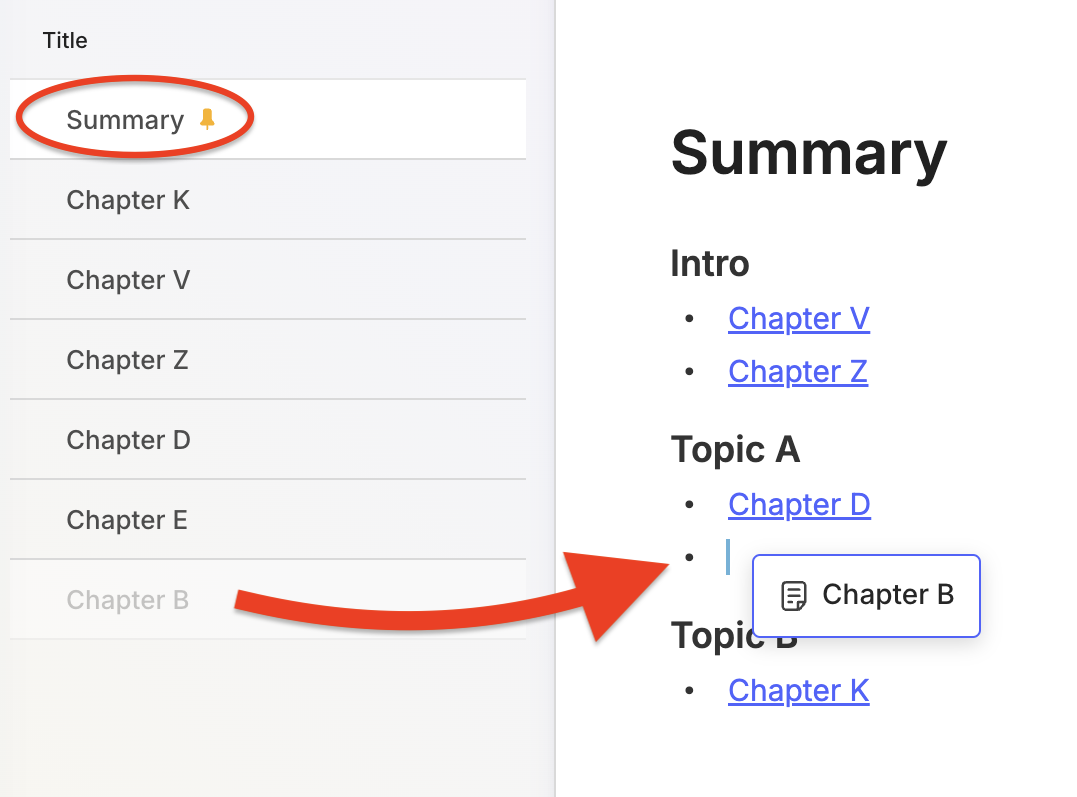
It might be possible to have the list of notes ordered correctly by adding chapter numbers to the titles and setting the notebook order to alphabetical. But this would create too much friction every time I wanted to reorder chapters or add a new one in between existing ones. In other words, there’s no point in doing this, as I can easily do it on the Summary note by dragging the items up and down.

I have tried to use Evernote for this several times, but I have not been successful in the past. It was never as fluid as it is now. At first, I thought the new pinned note feature was making me more confident this time. It’s definitely helping because when I’m writing, I tend to jump from one chapter to another a lot.
However, another thing I frequently do when writing is reordering ideas (the chapters). So, after a while, I came to the conclusion that the not-so-new option to drag items up and down in a bullet list is also playing a significant part.
The book, or an online course, or both, is still in its very early stages. But if you are a supporter on Patreon or YouTube, there is a video for you where I demonstrate the notebook in my real account while discussing my process.
One-Time Setup, Longtime Rewards using Evernote Advanced Search
Unlock the hidden power of Advanced Search! One simple setup can transform the way you use Evernote.
Evernote search was always excellent, but before the AI-Powered Search, the only way to go a step further was by using the Advanced Search, also known as Evernote Grammar. The simplest way to describe it is as a set of commands that we can combine with each other and type in the search box to filter notes in a very specific way.
The Grammar is so powerful that it serves as the backbone for the AI-Powered Search. When you perform an AI search, the AI first converts the information you typed into an Advanced Search syntax. That’s what is used to filter a group of notes that are sent to the large language model, which then generates the answer you end up seeing.
The commands, also known as terms, are not that difficult to understand, but some are pretty hard to memorize. Which means that with the introduction of the AI-Powered Search, there’s no point in using them for everyday searches. However, I see them as super useful for creating dynamic Saved Searches or Widgets.
I could, for example, use the codes below to create a Filtered Notes Widget on Evernote Home that would show me all notes in my ‘Creator’ notebook without the tag ‘Done’.
notebook:Creator -tag:done
If you type the above into the ‘Keywords’ box of the Filtered Notes Widget, you’ll create a dynamic group of notes. Every time you add the tag ‘Done’ to a note in the ‘Creator’ notebook, that note will automatically be removed from the widget.
There’s a series of videos I’m producing to help you understand and use the Advanced Search. You can check out the most recent one below about Reminders to understand how powerful it is. If you decide that the Advanced Search can help you create a better system for your Evernote, take a look at the other videos and have fun.
The aha! moment that ended my lifelong organizing struggle
I spent years searching for a solution! Here’s how Evernote finally helped me conquer information overload and organize everything.
While enjoying some old pictures yesterday, I noticed something that brought back a very specific memory.
Some of them, which date back to my childhood, have a code on the back. I can’t remember exactly what it means, but I know that the comma separates two types of information.
One is related to the order of that picture in a sequence. The other indicates the group, which would translate into something like the digital albums some people create nowadays.
In the example below, it would mean something like the second picture of a group (album) with the number 13. It may also be the other way around. I don’t know which one it was. The codes would be written in a paper notebook with additional information, such as descriptions of the album and pictures.
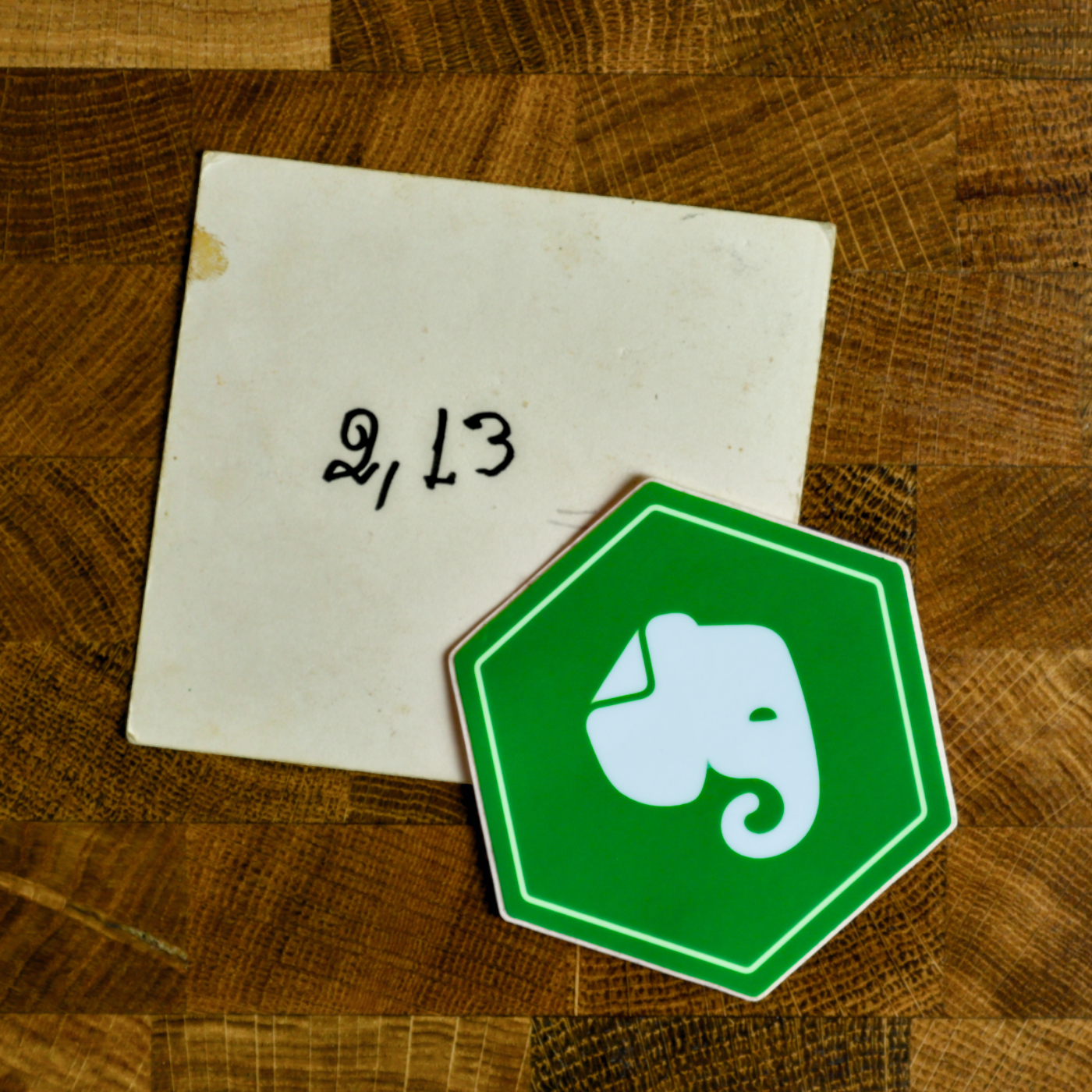
I used a variation of this system for many years. For example, when I started using a computer to write my letters, I had a two-digit code associated to the name of each person and the date in reverse order. Something like AC19930429. Similar to the pictures, the codes had a description associated with them, but at that point I was using a spreadsheet on my computer to log everything.
When I learned how to use databases, the system further evolved. In addition to storing the codes, the database had keywords from letters, documents, books, and articles from printed magazines.
I spent too many years perfecting this system, but the reality is that it was horrible. Probably because the digital database was only capable of cross-referencing the keywords I added to it. All the related information was still in physical media, and archiving and retrieving it was never a pleasant or efficient experience.
Time to simplify things
I eventually gave up. In addition to being a terrible system, this happened during the 1980s and 90s, a period known for rapid development of computers and the lack of cheap and reliable backup solutions.
However, I was not abandoning the idea of creating a system for my memories. As an early user of the Palm Pilot at the end of the 90s, I created a basic version of my system that I could carry with me everywhere.
Years latter, when Apple released Spotlight, it blew my mind. I understood that I would no longer need to organize information. At some point in the future, I would be able to simply ask for it and the computer would show me the related documents.
Little did I know that that dream would take many years to come true. Furthermore, there was a practical issue to consider. Spotlight was a Mac-only feature, and I needed something that would also run on my Palm Pilot, or simply Palm, as it was known at this point.
Despite there being no apparent solution, I kept adding my personal and professional stuff to that remarkable little computer, which I carried with me everywhere. I was so passionate about it that a website dedicated entirely to it ended up being my first online venture. And in October 2000, I was even asked to write a piece about how the Palm was going to change the world.
In the end, the smartphone did what I thought Palm would do. That’s okay. But one thing that saddens me is that I always thought that shared knowledge would make us a better civilization. I was probably too naive, since I never thought we would become so divided as a society. But that’s a topic for another moment.
16 years ago
I officially began using Evernote exactly 16 years ago today. I know this because I saved the welcome email using Web Clipper. However, it took me many months to fully commit to it.
That was the first time I had to deal with a chronological system to organize notes, with only one level of folders (notebooks). Back then, stacks didn’t even exist. As someone who had only used folders, a complicated coding system, and databases, I guess my perception of Evernote was destined to be the most negative possible.
I stopped using it several times in the first few months. The only thing that kept me coming back was being able to synchronize my notes across multiple platforms. Remember that back then, even the Apple ecosystem would not allow us to synchronize Mac notes with the iPhone.
But what ultimately made me stay was the fact that I decided to fully embrace the simple structure of notes inside a notebook and the chronological order of the notes, which I stand for until these days.
Like magic
I couldn’t see it at first, but Evernote instantly merged the two parts of my unusable childhood system. I could finally have the information and the database in the same place. Even better, I didn’t even have to build the database. It was finally just a matter of searching and finding.
Other times it was just a matter of looking at Evernote and finding. The way it arranges and presents our notes evokes a sense of clairvoyance. But it’s simply the way our brains work.
If I just used a note, it is highly possible that I’ll need it again shortly. Evernote has many features, such as Recent Notes, Switch To, and even the Notes Widget, which displays notes ordered by recently used. If you need to find something, visiting one of these places can be magical.
Even though I graduated as an economist, I always liked reading psychology books about memory. They helped me see how chronology plays a big part in how we remember things. The more I studied and learned, the more I realized how bad of an idea it was to keep excessively categorizing things.
However, it was the book Algorithms to Live By, which I read in 2016, that really connected all the dots. I consider that book to be my manual for organizing everything in both the real and digital worlds.
Old habits die hard
Thanks to a simple 2,13 code on the back of a black and white picture, I now understand that the system I’m currently building is the culmination of something I started many decades ago. I could not accomplish it back then because technology was not there yet.
We now have access to advancements well ahead of anything I could ever imagine. Not only is Evernote finding and showing me related notes, but it is also giving me answers based on my notes.
You’ve been watching me dismantle my entire collection of notebooks in Evernote and letting the tags and chronology help me find related information. What you probably don’t know is that I started sharing some of these ideas many years ago in my workshops, podcasts, and blogs, but I never fully embraced it until very recently.
I’m finally letting it go and trusting Evernote like never before to find what I need. As you know, the few notebooks I still have are there to help me do my work, not to be a knowledge or storage category. I’m still using tags, though. But I hope to also let that go as the search results start serving me the correct information.
2,13 is long outdated and has to go.
To celebrate my 16 years using Evernote, I released a video for supporters on Patreon and YouTube showing and talking about (almost 🫣) all the items I have in my big collection.
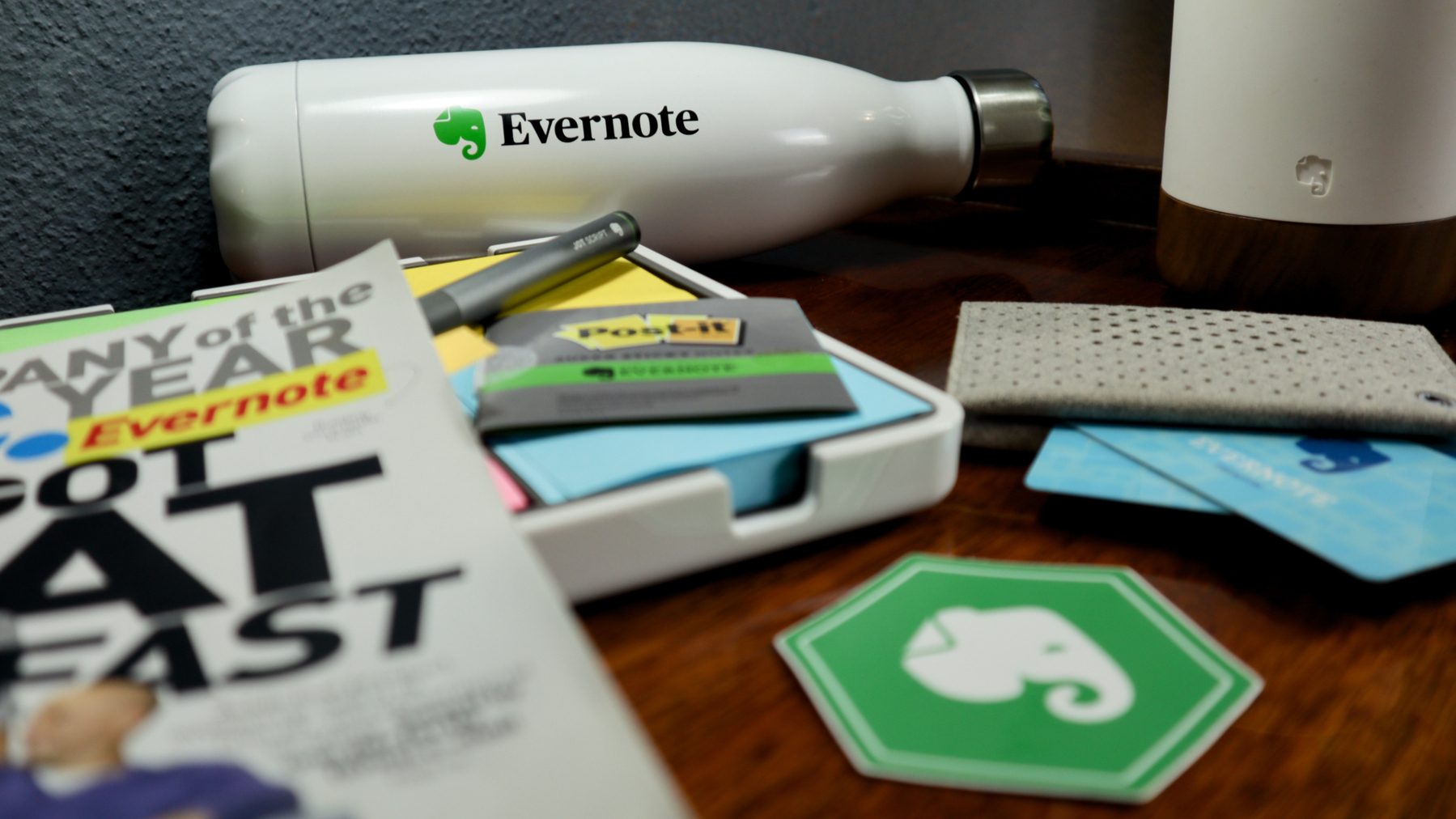
A little tweak to my system.
The YouTube notebook was renamed to Creator. Here’s why:
What’s good about having all the Creator related notes in a single place is the fact that when I have an idea, I usually don’t know if that will become a post like this, a video, or an article. I just write it down.
Moreover, it’s not unusual for an idea to become a video and an article. Which means that I can now use a single note with two different tags.
These are the tags I’m currently using for the notes in that notebook:
PS.: If you missed the explanation about the ECE notebook, please watch this video.
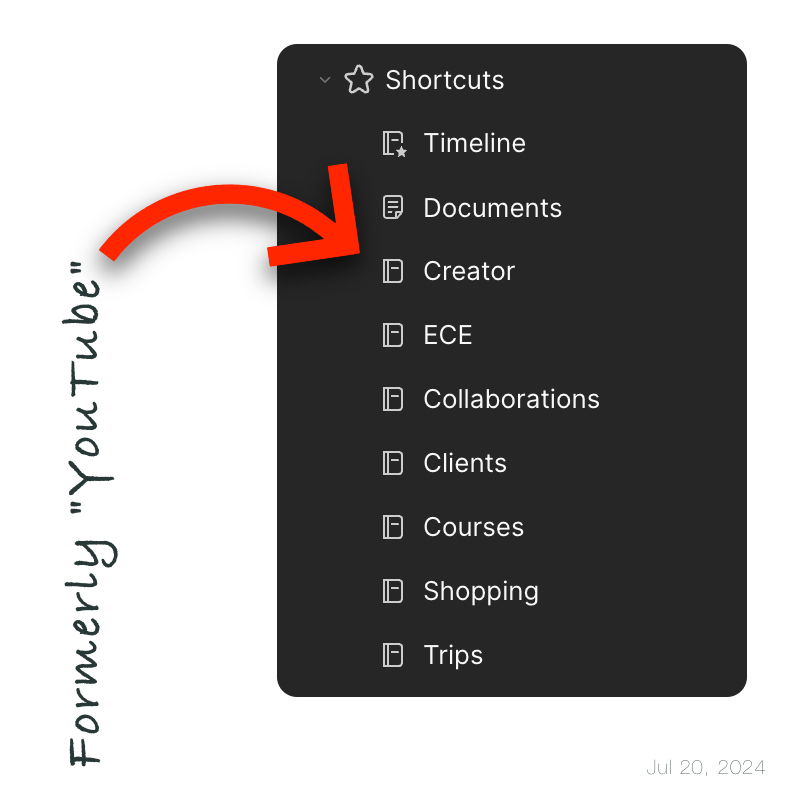
Simplify for Evernote Efficiency
It’s unlikely that sugarcoating will make our system more efficient.
I used to keep notes for each session with my clients or meeting with partners, and other notes for each team member, and even some for other purposes. Since they were all connected, the system worked pretty well.
This was mostly done for two reasons:
Furthermore, the number of different types of notes would automatically provide statistics based on the backlinks. For instance, I could know how many meetings a client had or how often a team member attended meetings. However, if you ask me how many times I have used this information so far, the answer will be an overwhelming zero.
As you already know, I have been simplifying things on my Evernote. Recently, I decided to try to organize all the above information in single notes with the the help of new Evernote features like headings, links to headings, calendar entries, etc. No statistics, of course. But that’s okay. Although they were always quite cool to look at, I didn’t use them at all.
Anyway, I’m still not quite there yet, but I’ll keep working on it. And, as usual, I will share the results on my channel as soon as I’m satisfied with the new system.
Perhaps we avoid it because it is challenging to simplify things. That’s the reason I keep reminding myself that there are always things that can be removed, especially unnecessary processes.
It’s rare that sugarcoating, categorizing, and a myriad of other routines will result in efficiency.
Evernote Just Made My Life Easier.
Recent quality-of-life improvements to Evernote are making my system even better.
Better Synchronization
Remember that video I published a few months ago about Evernote moving away from the monolith? If you haven’t watched it, think of the project as a lot of work under the hood to enhance the user experience.
Evernote has taken another big step in that project. Synchronization is currently being upgraded to a more modern system. All web clients have already been upgraded and the rollout of desktop and mobile apps is already underway. This is huge news!
All of my apps have recently been upgraded, and after a few days of testing, I’m amazed at how efficient synchronization is now. The video below explains how to know if your account is already running the new system.
Mobile Clients
Based on the results of a recent poll on my YouTube channel, most of you are using the new Create page on the mobile client to create your notes.
That’s not my case. As you already know, I have the app on my phone set to always open on the Shortcuts page, where I have access to the notebooks I use most of the time. In other words, I always open a notebook first, and then I create a note. So much so that I simply don’t remember the Create page exists and rarely go there.
Evernote 10.95.2 (mobile) underwent minor cosmetic modifications that I am in love with. If you go to the notes page, you’ll see a “new note” icon in the bottom-right corner. The same is true for notebooks, tags, and tasks. Not the calendar, though. At least for now. But don’t worry, it’s coming.
The shortcuts page was also upgraded. It’s a small change, but I also loved it. The list of recent notes is now gone, and that translates into more space for my shortcuts, which are a pivotal element of my new system.
You can find further information about the new features and my thoughts in the video below.
Thank you, Evernote, for helping me take good care of my furry friend.
I would prefer not to share this story today, but real life is certainly not all roses.
My lovely dog, who is incapable of hurting a flea, was bitten yesterday. He was enjoying himself at the dog park when another dog rushed towards him and bit him for no apparent reason. To my untrained eye, that was a giant wound that terrified me to death. But later at the vet, I was told that everything was alright since it was only the skin that was cut. Regardless, almost 4 cm (1.5 in) still seems like a lot to me.
Needless to say, this broke my heart, and it took me a long time to fall asleep yesterday. To be honest, I’m still a bit shocked, and this is definitely a story I would prefer not to add to my Elephant’s Journal. But life isn’t always perfect, is it?
Anyway, it happened late at night, and his usual vet doesn’t have an ER. When we reached out to him, he suggested the one we ended up going to. But since this was our first visit to the place, they did not have a file with my dog’s information. His microchip helped with basic details and some vaccines, but Evernote played an important role as it’s where I keep his entire life history.

As I said in yesterday’s video, all my family documents are in the Family notebook. They all have at least two tags: Documents and the name of the person or dog 🐾 that document belongs to. His birth certificate, passport, vaccine card, etc. are all there. And they are all listed in the Documents note, with links back to each of the notes containing the documents.
So, I can either open the Documents note to see a list of the most used documents, or use the tag with his name to filter all his notes in the Timeline notebook.
Another note that I keep in the Family notebook is called Caffeine’s Routines. Yes, his name is Caffeine 🖤. This note starts with a list of all the veterinary appointments in reverse chronological order, linking back to the notes in my new Timeline notebook. All of them also have at least two tags: Caffeine and Veterinary.
Again, I have two options to get to the notes. I can either open the Caffeine’s Routines note to see the list and click on a specific item, or use the Caffeine plus Veterinary tags to filter and see all the notes.
Below that list, I have several tasks, such as his vaccinations and deworming. I even have a task to remind me to give him a bath 😊. All these tasks will automatically show up on the Tasks' widget I keep on Evernote Home.
There is also a link to the Caffeine’s Routines note in the Documents note. Yesterday, at the vet, all I had to do was open Evernote, which in my case is set to open on the Shortcuts page. From there, I taped on Documents (note) and had access to a list of his more relevant notes to answer all the questions the veterinary had.
When I got home, I used Evernote to scan the receipt and the veterinary recommendations, then added the Caffeine, Veterinary, and Health tags, and saved the note in the Timeline notebook. Finally, I added a link to that note to the list on the Caffeine’s Routines note. It took me less than a minute to update the information, which will give me peace of mind in the future.
I’m sure my furry friend will get better soon, but I’m still heartbroken. When I feel less stressed about all of this, I will make a video to better illustrate all the steps above. For now, please show your pet some love. These little guys are absolutely wonderful.
I broke Evernote 🫣
Remember I told you in the last video to be careful when making significant changes to your Evernote? I was following my advice, but… 🫣 Also in today’s video, I talk about the recent updates to my system and some unexpected benefits.
UPDATE: I had to put the Timeline notebook back. I just noticed that the reason it's there is to let me easily drag to that notebook completed activities (notes) from any of the Backlog notebooks. To better understand it, please take a look at the image below.

Yesterday, I ended up not working on my Evernote because the video recording and editing consumed a lot of time. Today, things are moving forward quite well. I am now down to 36 notebooks from the 51 I originally had in that Legacy stack.
Evernote Templates are broken and driving me crazy. But there's a solution!
I believe that the Bending Spoons deal was the best thing that ever happened to Evernote, but some new features may be adding even more confusion to old problems. For example, I would love Federico’s team to tackle the huge mess Templates is already making before it turns into an uncontrollable snowball.
I have been brewing this idea for over 10 years!
Everything clicked when I looked at a scrap piece of acrylic board from one of my maker projects.
I want to start by saying that this is not for task management. The goal is to have a clearer view of all of my current and upcoming activities by giving me a bird’s-eye view. Apps like Evernote, Obsidian, and others can handle all the details much better. However, there are still some adjustments I would like to make to the system before I share the specifics of how it works.

For now, let’s talk about the form factor.
I used different colored rubber bands just to make the picture more interesting. The real ones are black, as you can see in the picture of the prototype below. In other words, the colors have no special meaning at all. As for the material and size, there is a reason for that.
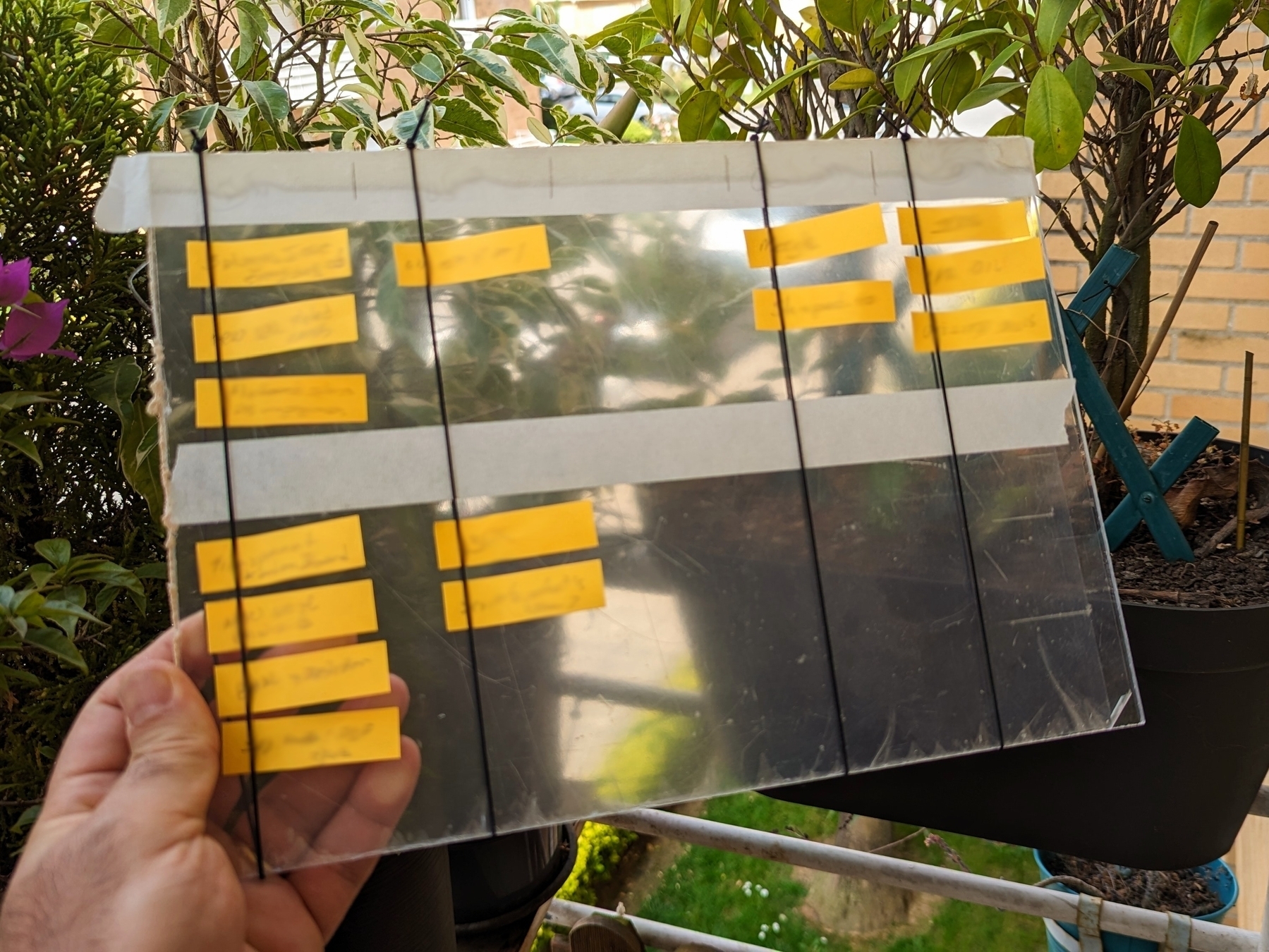
Given that it will be on my desk most of the time, I would like to always be able to see what is underneath it. That’s why it is transparent. It is the same size as an A4 sheet of paper, which gives me plenty of room to run my system and safely transport it without losing sticky notes. It’s as easy as slipping it into any folio available on the market. Or, like I’m currently doing, just repurpose the paper ones companies give us with proposals or contracts inside.
I wanted something that could be hackable by anyone, and that’s why I used standard measurements. Nevertheless, I am confident that the equivalent of a letter paper size would be a more suitable option for users in the United States.
As things progressed, being hackable became a must-have aspect. For example, at first, the dividers were created with masking tape, but later, rubber bands were used to make the board easier to adapt to new situations or different uses. In the end, they also proved to be useful in preventing sticky notes from falling off.
Vertical lines create stages that work almost like a Kanban board. Almost! Regarding the horizontal divider, it creates what one of my clients nicknamed Driving Lane (top) and Parking Lane (bottom).
I’ll tell you more about the system soon, but don’t expect anything advanced or complicated. On the contrary, it is something simple that covers all of my needs.
I think the hardware is what freed my mind because until now, I couldn’t make my system work 100% with available software. Ironically, following the construction and testing of the board, it opened my eyes to the possibility of implementing my system on some apps. But now, I’m not certain if I want to go that route. Anyway, I’ll also share more about that soon.
I made myself a tool to make it easier to film the Supernote. It is essentially a miniature table with an acrylic top to let the light through. I also cut it to fit the Pixel camera bump. And yes, the next video will be about sending Supernote files to Evernote 😉
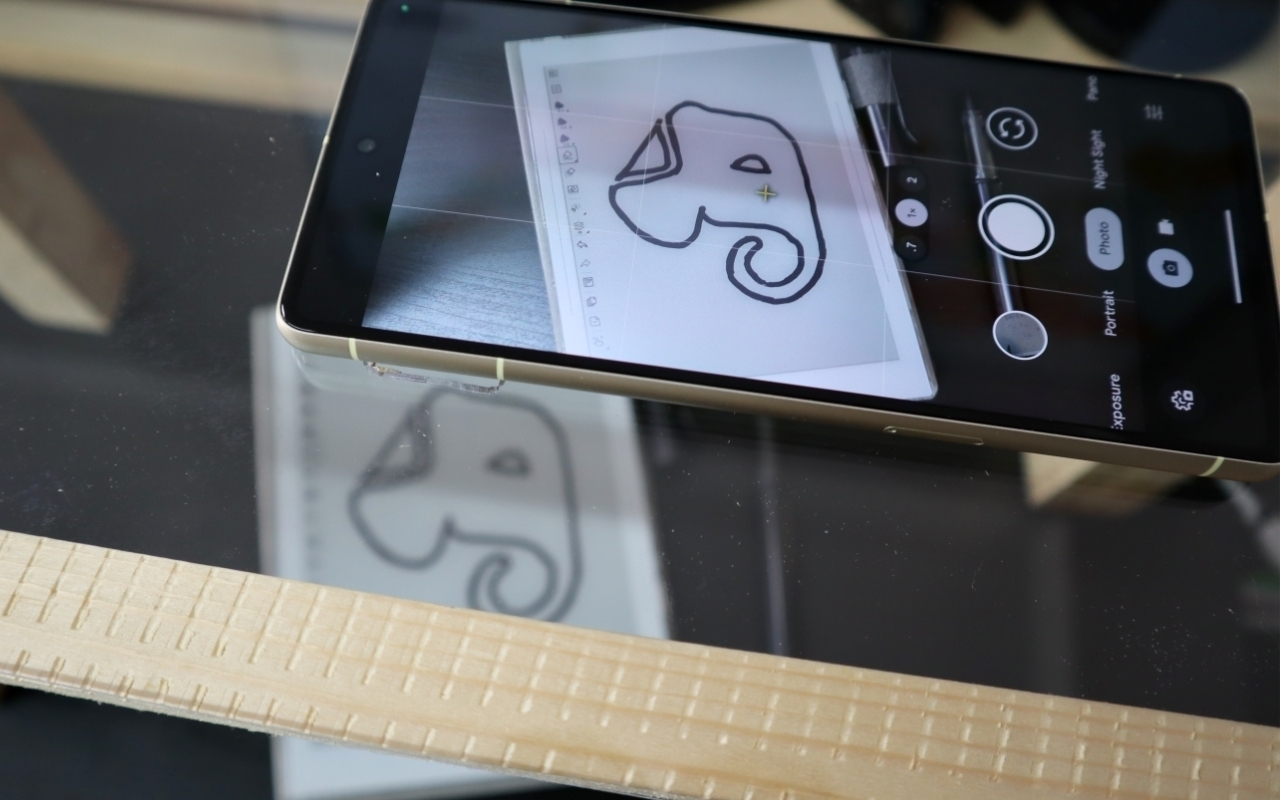
Customizing Evernote is a must-have option because everyone uses it differently
Every so often, I get the impression that Bending Spoons is following some of the same problematic routes that have already been attempted before them.
I love how fast the new mobile experience is, and I’m sure people who create notes mostly on their phones are happier than ever. But what I’m feeling is discomfort. It’s now 5 days since I started using the new Evernote home for mobile, and I’m yet to use the main screen as intended.
Stacey Harmon said it best: “I have to think about it a lot more than I used to”.
[!cite] (…) I’m really struggling to embrace the new Home. It is not clicking for me. (…) I’m missing the customized create button. The options there don’t reflect my preferred capture ways. (source)
[!cite] I also am just struggling to navigate the app and get to what I want. I’m not finding it intuitive… I have to think about it a lot more than I used to. (source)
If we go all the way back to 2014, when Evernote 7 adopted a modern interface to replace the previews skeuomorphic design mimicking a Rolodex, some complaints were about the lack of customization. Which the company ended up addressing.
When Evernote 8 for iOS came out, customization was gone again. And, as inevitable as gravity is, I remember people asking for many settings. One of the more prominent among my community was a way to turn off the recently used notebooks from the top of the notebooks list. Which, by the way, I didn’t felt the need to remove. In fact, I liked it. And that’s precisely my point.
Customizing Evernote is a must-have option because everyone uses it differently. So much so that Evernote 10 brought back many ways to personalize the app. Unfortunately, that’s now gone again.
But credit has to be given when it’s due. Bending Spoons was able to put together a user interface that has the best elements from many older iterations.
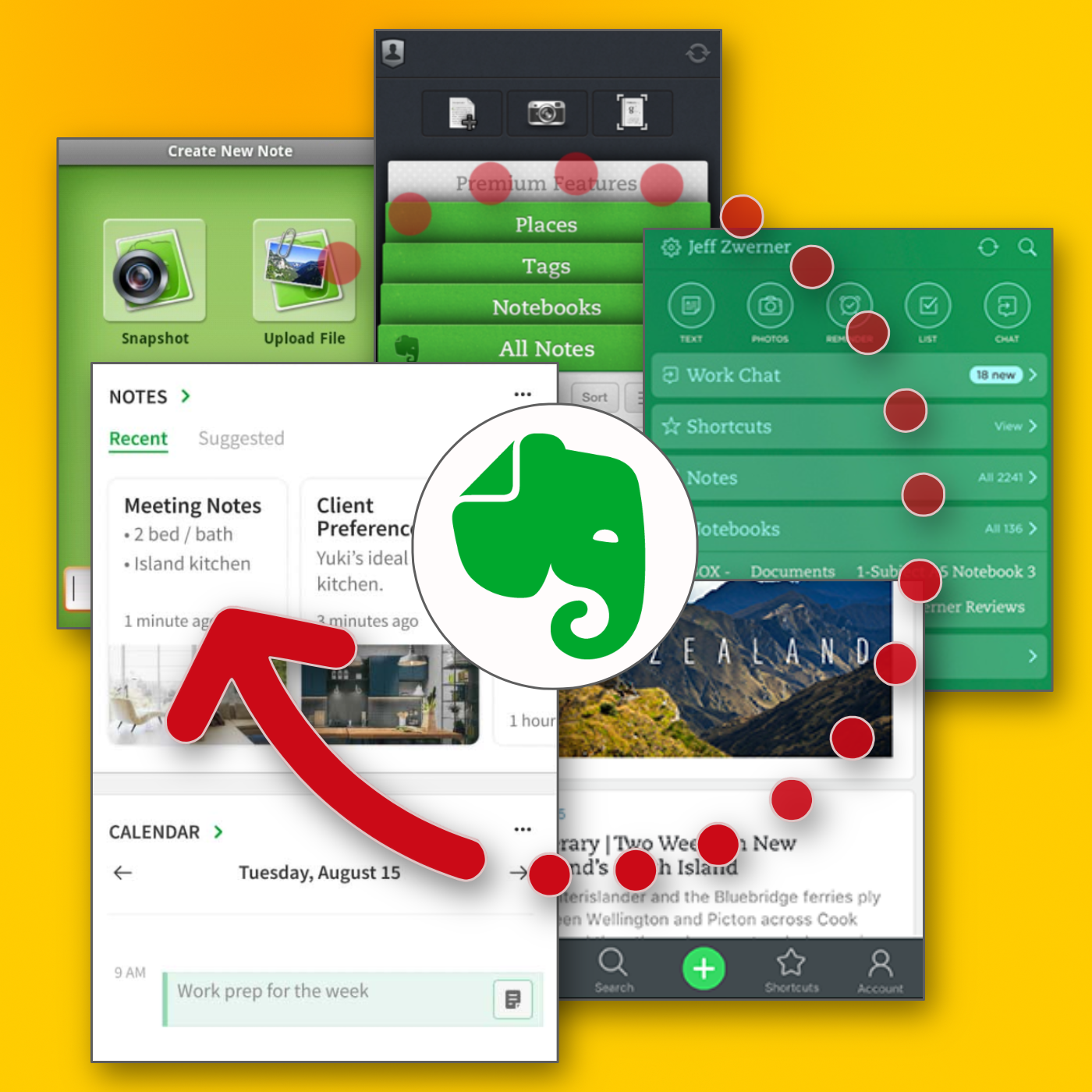
The creation buttons that were used on the first versions of the app are back. Then there’s the dock from Evernote 8, which makes it a breeze to switch from one view to another. And there is even a widget borrowed from the original version 10. To top it all off, this might be the fastest Evernote app ever released.
There’s just one missing piece: customization. And that’s something they could’ve learned from history. Evernote users need options simply because each one of us has a different vision of what makes the perfect Evernote experience.
And talking about history, in the second part of the video below, you can see a glimpse of how I try to keep Evernote’s history intact. Ironically, I do that using Obsidian.
New Evernote Home for mobile. Did I like it? Well, I have some suggestions
The Evernote mobile apps for Android and iOS have changed a lot over time. But one thing all the versions have in common is the struggle to strike a balance between using the notes we already have and capturing fresh info.
The creation buttons were always there from the very beginning, but eventually, they would be combined with different ways to get to existing notes. Sometimes, they would be more prominent at the bottom or top of the screen, as in the newly released version. Other times, a drop-down or Rolodex-style would take up more screen real estate to make old notes easier to find.
Around version 4 or 5, a star icon was added to the dock for quick access to the Shortcuts, which back then were called Favorites. Variations of the star would exist for numerous subsequent versions, occasionally being eliminated only to be reintroduced. The one I liked the most was a little notch at the bottom of the screen.
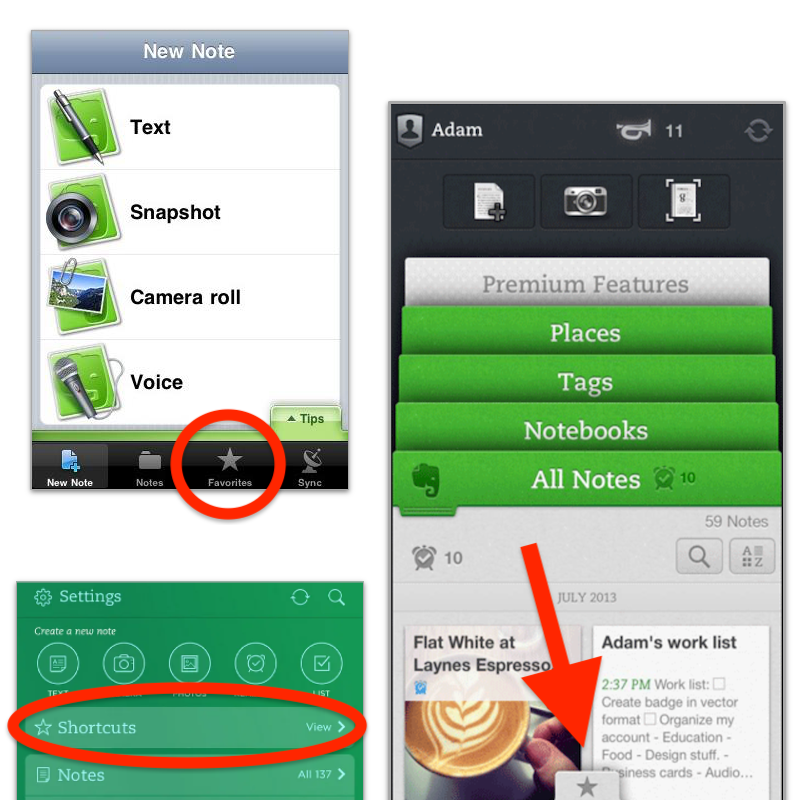
With the introduction of Evernote 7 for iOS, something similar to the current widgets was introduced. Users would be able to select which Rolodex-style cards they’d like to be visible, and sure enough, Favorites was one of the options.
Favorites or Shortcuts were the best way to get to specific notes before Evernote Home existed. But now there’s no quick access to either. Both are two taps away from the new Home screen. So, here’s what I’d like to see improved on this new mobile client.
First, I think we can agree that there’s enough room on that screen for a small star. Regardless of where it is put, we need quick access to a selected group of information in the form of notes, notebooks, etc. Also known as Shortcuts.
I know for a fact that many users love the Scratch Pad. One of my clients even uses it as a way to create all his notes. But I believe there are already enough “creation options” (buttons) on that screen to give advanced users a way to replace the Scratch Pad with another widget. In my case, for example, a Filtered Notes or Pinned Note widget would be of much more value.
Finally, the mobile widgets page settings should be completely independent of the desktop and web clients. As shown in the video below, I still see value on the widgets page, and I came up with a workaround to make it more pleasant to use. However, with quick access to Tasks and Calendar on the dock, there’s no need for these widgets on the old Home anymore. The problem is, if they are removed from there, they will also be removed from the desktop and web clients, where I do need them.
Also regarding settings, I am curious as to why the removal of the Scratch Pad widget from the old widgets page will also remove it from the new Home page.
What about you? Did you like the new Home for mobile? I would love to know your thoughts.
I use Evernote, Obsidian, and others. Why isn't one app good enough?
Not all applications in my Toolbox are incorporated into my personal workflows.
There are two groups of apps in my Toolbox. First, there are the ones I use in my workflows and to help my clients. The second group consists of apps that I don’t use. They are options for my clients that are regularly selected from the numerous tests and experiments I’m constantly doing. Occasionally, they are also featured on my YouTube channel.
The Mighty Trio
For example, Trello, which I don’t personally use, is one of my preferred options when it comes to helping companies build workflows. My clients usually don’t have much time and don’t want to spend it with settings. They appreciate how simple and intuitive it is to understand and use Trello.
In other words, the team doesn’t waste time during the implementation of the new process or, after that, in production. Furthermore, it typically takes me only five online sessions to assist small business in establishing their workflows, acquiring knowledge of Agile and Kanban principles, and applying them to Trello.
The same is true for Evernote. I am constantly approached by CEOs and managers, who are overwhelmed with the amount of time they are wasting with all the possible configurations apps like Notion offer.
The fundamental components of Evernote, namely notes and notebooks, require minimal effort to understand and use. Then there’s the outstanding search. Give busy people a way to quickly find information, even in a messy environment, and they’ll be forever grateful.
Its simplicity is still unmatched today. That’s why I still use Evernote for many things, especially the ones related to the calendar, even though I’ve been using Obsidian a lot. More on that soon.
Its powerful search is also very much appreciated. For instance, if someone contacts me, and I’m not sure if we’ve met before, I’ll search for their email address on Evernote looking for notes related to past interactions. This is something I frequently do and it’s magical.
More recently, I moved my tasks back to Evernote to try two new features. The full-screen view and tasks on the calendar.
Then there’s Google Workspace, which is equally easy to use and intuitive. But that doesn’t make it less powerful. The real-time collaboration it offers is unparalleled and almost unbreakable. When you add in the fact that documents can be linked to Evernote, Trello, and so many other services, it’s a truly unique product. Sometimes it even works as a bridge between apps.
Many of my clients, from different industries, adopt a variation of a workflow that starts with outlines on an Evernote note and resources clipped into a notebook. When the time comes, a Google Doc is created and linked to that note. These two simple steps ensure that the research material, outline, and draft of the final document are all easily accessible.
Eventually, the document reaches a stage where more team members are required to collaborate on it, and it is now shared on a Trello board. Other times, it is shared on Slack, instead of Trello. And that’s fine because the document is always the same. No matter where it is, everyone will be able to work on it while Google’s real-time editing will be doing its magic.
It’s also a matter of taste. Like many of my clients, I simply cannot stand all the buttons and so many settings on Microsoft products. I’ve been a happy Workspace user since 2015 and have no intention of leaving anytime soon.
These apps are formidable, as they are all intuitive and work seamlessly together. I can’t remember how many companies I helped with this trio.
Obsidian
Some of you may recall the series of videos I made about moving the files I had in Evernote to Google Drive. That idea came from Obsidian, which I started using long before Evernote was acquired by Bending Spoons.
My written content has many media elements. Sometimes it is a thumbnail like the one you see in this article, other times it’s a clip that I plan to use in a future video. Sure, all these files can be added to Evernote, but there’s no easy way to work on them out of the note.
The thumbnail in this article, for instance, was initially created on Pixelmator before being converted to a JPG. And that is an ideal use case for Obsidian, which keeps notes and all files in our computer files system. We can access and use them from Obsidian or from the computer file system. It doesn’t matter. In other words, I can include the thumbnail in a note, like the one I created for this article, and, at the same time, edit it using whatever app I wish.
While we are discussing this topic, I have always had the desire to post directly from Evernote, but I was never able to find the proper solution. That’s not the case anymore. For a while now, all my articles and short posts start their lives as a note on Obsidian, which brings us to another tool I love.
Micro.blog is now my hub from where I manage all my online presence. It’s a great tool and there are many videos about it on my channel.
Another interesting workflow is the draft of my next book, which I can write on Obsidian and synchronize with Scrivener. Again, that’s only possible because of how Obsidian notes and files are stored on our computers.
I believe you got the point. I’m using Obsidian for all file-related workflows.
Workflow as a Concept
Since English is not my primary language, I frequently require assistance from technology. LanguageTool is my grammar and spelling tool of choice, particularly because it’s a European company with a strong privacy policy. Sadly, there is no Android app available, but that’s okay since most of the time I’m writing on a computer. Which brings us to a workflow I established for my writing.
As you can see in this video, LanguageTool saves temporary or permanent texts. When I have an idea, I create a permanent text, work on it for days, weeks, months or for as long as it takes, then I paste it to Obsidian, format it, and publish it on my blog from there. The last step is adjusting the text saving format to temporary, which will automatically delete it from LanguageTool after a few days.
That’s what I call a Workflow as a Concept. You don’t need to use a Kanban board or an app to plan and keep track of all the stages. If the process is clear to you, a simple temporary-permanent text setting will suffice.
Hardware
I recently started using a Supernote, and similar to what I described above, it is now part of a Workflow as a Concept. I don’t know why it happens, but very time I come back from a run, I have this storm of ideas that I have to write down.
Writing all of that on my computer or phone was never a viable option. There’s too much friction. What I do now is grab the Supernote and take notes with tags that will help me filter that information in the future. Sometimes it’s just an outline, other times it’s a sentence or two.
I’m in love with how simple and efficient this is and will soon talk about it on the Supernote series on my YouTube channel.
And talking about running, my watch of choice is a Garmin Instinct 2. I stand for all the reasons I listed in the 2-year-old video below. The only complaint I have is something I found out much latter. Its battery is not replaceable. And although it’s still averaging 20 days in between charges, a sealed device is something that makes no sense in today’s world.
There are, of course, more software like Firefox, Signal, Final Cut, Apple Motion and others, but this article is already too long, and I’d say the above are the ones that really make my workflow flow.
I had to go back to Evernote Tasks
I was pretty happy with my system running on Google Tasks, but there are so many new things happening to Evernote Tasks that I had to go back.
Not too long ago, I wrote about moving my tasks from app to app and how good it is to rely on a system instead of an app. In other words, it means that I can basically make it work anywhere.
Yesterday I mentioned that Evernote had made the full-page Tasks available to many of us, including me, and that I would use it for a while before expressing my opinion. I also hinted at the possibility of tasks coming to the calendar. Well, as illustrated by the tweet below, that one was quick.

There you have it. I’m back to Evernote Tasks and will be sharing my insights with you along the way.
